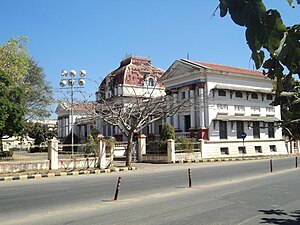Oriental Research Institute Mysore
 Oriental Research Institute front facade | |
| Established | 1891 |
|---|---|
| Type | National library |
| Location |
|
| Coordinates | 12°18′23.07″N 76°38′24.5″E / 12.3064083°N 76.640139°E |
Patron | Chamarajendra Wadiyar X |

Formerly known as the Oriental Library, the Oriental Research Institute (ORI) at Mysore, India, is a research institute which collects, exhibits, edits, and publishes rare manuscripts written in various scripts like , Brahmic (Sanskrit, Kannada), (Nandinagari), Devanagari (Sanskrit), Grantha, Malayalam, Tigalari, etc.
The Oriental Library was started in 1891 under the patronage of Maharaja
Work
From the year 1893 to date the ORI has published nearly two hundred titles. The library features rare collections such as the
One day a man from Tanjore handed over a manuscript of Arthashastra written on dried palm leaves to Dr Rudrapatnam Shamashastry, the librarian of Mysore Government Oriental Library now ORI. Shamashastry's job was to look after the library's ancient manuscripts. He had never seen anything like these palm leaves before. Here was a book that would revolutionise the knowledge of India's great past. This palm leaf manuscript is preserved in the library, now named Oriental Research Institute. The pages of the book are filled with 1500-year-old Grantha script. It looks like as if they have been printed but the words have been inscribed by hand. Other copies of Arthashastra were later discovered later in other parts of India.[1]
In this context, my mind remembering a day which was the His Excellency Krishnaraja Wodeyar went to Germany at the time of Dr. R. Shamashastry were working as a curator of Oriental Library, Mysore, The King sat in a meeting held in Germany and introduced himself as the King of Mysore State. Immediately a man stood up and asked, "Are you from our Dr. R. Shamashastry's Mysore?" Because the Arthashastra edited by him took a fame worldwide. The King wondered and came back to Mysore immediately to see Dr. R. Shamashastry, and also Dr. R. Shamashastry appointed as Asthana Vidwan.

The ORI houses over 45,000
The conventional method followed at the ORI was to preserve manuscripts by capturing them in
Notable researchers
- A.R. Krishnashastry
- Dr. R. Shamasastry
In literature
The Oriental Research Institute is featured in the 2014 mystery thriller novel The Emperor's Riddles by Satyarth Nayak.
See also
References
- An article in The Hindu - A monumental heritage[usurped]
- An Article in Hindu - Mysore varsity renovating Oriental Research Institute
- An article in Jan Samachar
- An article in Star of Mysore about Arthashastra manuscript
- Architectural Heritage Building of the Oriental Research Institute, Mysore
- ^ JOYLAND (ourjoyland.in) issue 22 Mar 2017, page 2
